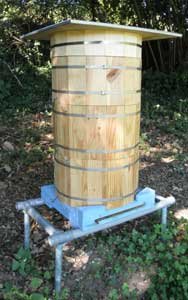
Wild Hive (Ruche Sauvage)
A summary compiled by David Heaf of material that used to be available in more detail on Claude Bralet's former web site at http://www.la-ruche-sauvage.com .

The hive described on this page was developed by Claude Bralet, of the Dordogne in France, after studying many traditional and historic hive types including the hive of Abbé Émile Warré. Regarding hive shape, Warré wrote in his book Beekeeping for All:
Abbé Voirnot gave his hive a square shape, because this shape was closer to the shape of a cylinder, a shape in which the distribution of heat occurs more evenly, but whose construction is too
expensive." (p.32)
And yet eight frames ... gave a square shape. And the square is the shape that best approaches that of a cylinder, an ideal shape because it favours the distribution of the heat in the inside of the hive. But the
cylinder is a shape that is hardly practicable." (p.40)
Furthermore, a width of 300 mm allows a square brood chamber to be set up. And the square shape, after that of the cylinder, contributes well to distributing the warmth in the hive. (p. 50)
So Warré clearly recognised the importance the thermological properties of a hive but in designing his 'ruche populaire' (people's hive) he wanted a hive that could easily be made by anyone capable of using a saw, hammer and nails. Nowadays, with modern power tools being accessible to many, it is much easier to make a cylindrical or near cylindrical wooden hive. Bralet suggests that his hive can have 8 or more sides. A hexadecagonal hive could be achieved simply by placing suitably shaped triangular section blocks in all 8 corners of an octagonal box.
Several Warré beekeepers have already developed polygonal hives with six or more sides, as well as round hives (see here). However, all these designs involve top-bars in each hive element. An important feature of Bralet's design is that it has no top-bars. Instead, to support the comb, at the top is a pottery dome with a few holes in it, and there are two spales (cross-sticks) in the element below the dome. Clay is still a common material for hives in hot countries and has been since ancient times. Like wood, it is permeable to water vapour. The dome becomes the honey reserve, as in Leroy's combination hive (ruche mixte).
In its hexadecagonal version the hive cavity closely resembles that of a hollow tree. It comprises three elements 200 mm high and 300 mm internal diameter between parallel faces. Elements are stacked one upon the other. The top element contains the pottery dome. Bralet regards this as the most important feature of his hive as it enables good thermodynamic regulation for the comfort and development of the brood.
Construction of hexadecagonal (16-sided) 'ruche sauvage' with windows
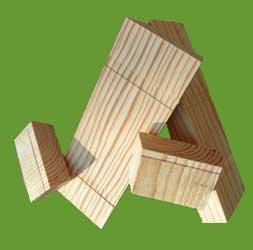
12 x 200 mm staves and 8 x 45 mm staves 27 mm thick are cut with outside edges 75 mm wide and outer corners angled at 78 degrees 45 minutes (78.75 degrees). Two 45 mm staves go in each section of the window which occupies 2, 3 or 4 sides. The window staves have rebates on their insides to accommodate the window glass. The staves are glued together and bound by two stainless steel bands tightened by screws. The bands rest in 10 mm wide shallow grooves placed 35 mm from each rim of the box.
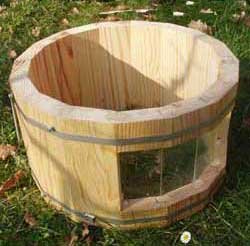 4-stave window
4-stave window 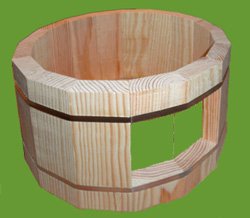 2-stave
window
2-stave
window
The gaps between the panes of glass are propolised by the bees. The windows are covered by polystyrene when not used for observation.
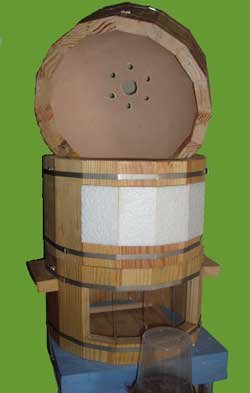
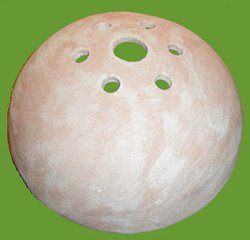
The dome rests in a notch cut in the side walls. The following illustration shows one stave with a notch. The source does not state the height of the dome, but from the photo it appears to be hemispherical. For an internal diameter of 300 mm its internal height would be 150 mm. This leaves 50 mm of the element's height to accommodate the thickness of the pottery and the notch on which the dome rests.
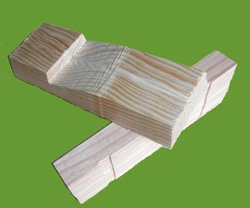
The dome contains holes for access for the bees to a top feeder. The feeder illustrated here appears to be a plastic Miller-type contact feeder.
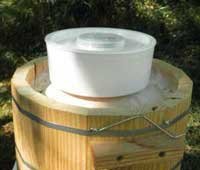
When no feeder is in place, the void over the dome may be filled with an insulating quilt, such as a cloth bag of wood shavings. The element immediately below the dome contains two circular spales (e.g dowels) secured to the sides two-thirds of the way up the walls. There are no spales in the bottom element.
The floor is fitted with a mouse guard. There is no alighting board as this helps Asian hornets, already present in France, to catch the bees. The hole at the back is designed for an entrance feeder.
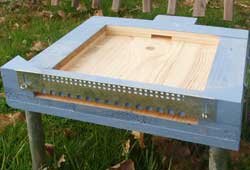
The hive rests on a stand of PVC tubing.
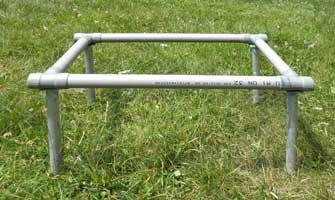
The roof is a simple square, presumably with a drip rim to prevent rain seeping underneath and into the hive. In the photo below the feeder eke is below the roof. If left on when not feeding, this could contain a quilt of insulating material. It would be analogous to the quilt of the Warré hive.
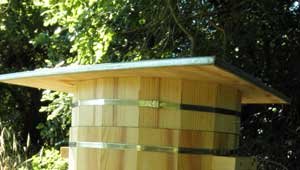
Another essential feature of this hive is its 'untouchable' natural brood nest. Three elements, two of full volume and one with the volume limited by the dome, give the brood nest a volume of 40 litres (calculation: 2 elements, each 20 cm high, with internal floor area of 834 square centimetres (total 33 litres), plus 1 element containing the dome of approximately 7 litres = 40 litres ). This is identical to Tom Seeley's choice of 40 litres for bait hives which prove highly attractive to swarms that are looking for a cavity.
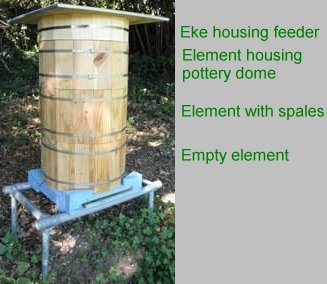 The 'Wild
Hive', complete with eke for feeder.
The 'Wild
Hive', complete with eke for feeder.
Management
A swarm is introduced into the hive. It begins constructing in the dome where its heat is easily concentrated. The comb is fully natural, whereas in the Warré hive the comb is only near-natural due to the fixed spacing between the top-bars and starter strips.
One method of harvesting is to place a super of combs on the top of the top (dome) element. The honey reserve in the dome is never harvested.
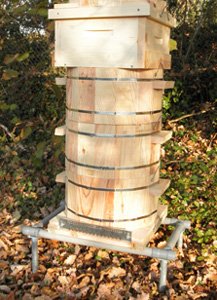
But what about renewing the combs, a feature built-in to Warré hive management through its regular nadiring of fresh boxes and harvesting at the top? Bralet suggests renewing the combs every two years using the method of Abbé Babiel, published in 1857 (see diagram below). The hive whose combs are to be harvested for recovering honey and rendering wax (A) is placed on a board (B) over an empty hive (C). All entrances are sealed except for the one in the new hive. The colony gradually grows down from A into C and eventually the brood nest is all in C. A can then be removed for harvesting. Bralet suggests doing this manipulation every two years, alternating with supering as shown immediately above.

For arguably one of the richest and most beautifully presented sites on natural beekeeping I used to recommend visiting Claude Bralet's site at http://www.la-ruche-sauvage.com, but it is no longer active.
John Haverson's and David Heaf's versions
Since creating this page, David Heaf and John Haverson corresponded on aspects of the design of the Wild hive and concluded that a dome of straw rather than terracotta would be more appropriate for an initial trial of the hive in the UK. Standard skep weaving technique was used with the raw materials being straw and lapping cane. It became clear that some sort of relatively smooth flat surface would be needed at the top of the dome for setting on feeders and mating up the dome to a super.
David Heaf's version of Claude Bralet's 'ruche sauvage' (wild hive)
John Haverson's version of Claude Bralet's 'ruche sauvage' (wild hive)